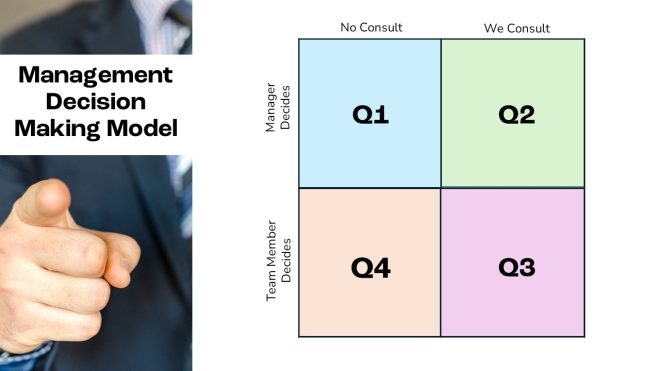In the dynamic world of business, effective decision-making is the linchpin for success. Yet, many managers grapple with the challenge of lacking a clear process. Fear not, for I bring you a practical model designed to simplify decision-making for small business owners and managers.
Let’s delve into this uncomplicated, yet potent, approach that promises to enhance the decision-making prowess of your small business team.
The Decision-Making Model
At the heart of this model lies simplicity, breaking down decision-making into four distinct quadrants.
- In Quadrant 1 (Q1), the boss takes the reins independently.
- Quadrant 2 (Q2) involves a discussion, but the final call rests with the boss.
- Quadrant 3 (Q3) encourages team discussions, but the team member makes the ultimate decision.
- Lastly, Quadrant 4 (Q4) requires minimal discussion; the team member autonomously decides.
This straightforward framework provides a roadmap for navigating the intricacies of decision-making within your small business team.
Quick Tips for Implementation
To seamlessly integrate this model into your business, set clear expectations for each quadrant. Discuss potential scenarios pertinent to your business, fostering conversations around roles and responsibilities.
For example, certain decisions may fall within the team member’s domain (Q3), while others necessitate the boss’s input (Q2). Making the model a regular reference point during discussions ensures a shared understanding among your team, promoting consistency and efficiency in the decision-making process.
Implementing with Your Team
When introducing this model to your small business team, simplicity is key.
- Explain it in clear, straightforward terms, and prominently display it in your workspace as a visual guide.
- Encourage your team to refer to it during discussions, creating a shared language and approach to decision-making.
- By making the model an integral part of your team’s dynamics, you promote transparency and efficiency, paving the way for smoother decision-making.
Conclusion
In essence, this accessible decision-making model is tailored to empower small business teams. By incorporating it into your operations, you simplify decision-making, enhance accountability, and foster a more transparent and efficient decision-making process.
For any queries or further assistance, feel free to reach out. Here’s to smoother decision-making and the success of your business!

